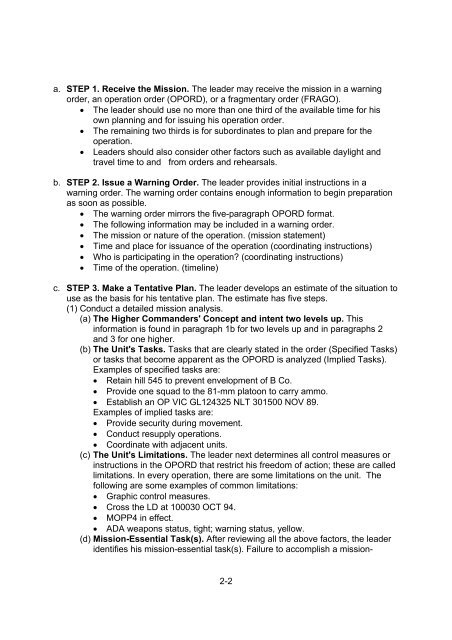You also want an ePaper? Increase the reach of your titles
YUMPU automatically turns print PDFs into web optimized ePapers that Google loves.
a. STEP 1. Receive the Mission. The leader may receive the mission in a warning<br />
order, an operation order (OPORD), or a fragmentary order (FRAGO).<br />
• The leader should use no more than one third of the available time for his<br />
own planning and for issuing his operation order.<br />
• The remaining two thirds is for subordinates to plan and prepare for the<br />
operation.<br />
• Leaders should also consider other factors such as available daylight and<br />
travel time to and from orders and rehearsals.<br />
b. STEP 2. Issue a Warning Order. The leader provides initial instructions in a<br />
warning order. The warning order contains enough information to begin preparation<br />
as soon as possible.<br />
• The warning order mirrors the five-paragraph OPORD format.<br />
• The following information may be included in a warning order.<br />
• The mission or nature of the operation. (mission statement)<br />
• Time and place for issuance of the operation (coordinating instructions)<br />
• Who is participating in the operation? (coordinating instructions)<br />
• Time of the operation. (timeline)<br />
c. STEP 3. Make a Tentative Plan. The leader develops an estimate of the situation to<br />
use as the basis for his tentative plan. The estimate has five steps.<br />
(1) Conduct a detailed mission analysis.<br />
(a) The Higher Commanders' Concept and intent two levels up. This<br />
information is found in paragraph 1b for two levels up and in paragraphs 2<br />
and 3 for one higher.<br />
(b) The Unit's Tasks. Tasks that are clearly stated in the order (Specified Tasks)<br />
or tasks that become apparent as the OPORD is analyzed (Implied Tasks).<br />
Examples of specified tasks are:<br />
• Retain hill 545 to prevent envelopment of B Co.<br />
• Provide one squad to the 81-mm platoon to carry ammo.<br />
• Establish an OP VIC GL124325 NLT 301500 NOV 89.<br />
Examples of implied tasks are:<br />
• Provide security during movement.<br />
• Conduct resupply operations.<br />
• Coordinate with adjacent units.<br />
(c) The Unit's Limitations. The leader next determines all control measures or<br />
instructions in the OPORD that restrict his freedom of action; these are called<br />
limitations. In every operation, there are some limitations on the unit. The<br />
following are some examples of common limitations:<br />
• Graphic control measures.<br />
• Cross the LD at 100030 OCT 94.<br />
• MOPP4 in effect.<br />
• ADA weapons status, tight; warning status, yellow.<br />
(d) Mission-Essential Task(s). After reviewing all the above factors, the leader<br />
identifies his mission-essential task(s). Failure to accomplish a mission-<br />
2-2


